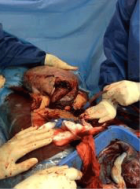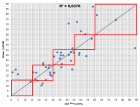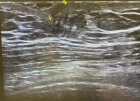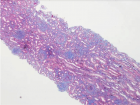Abstract
Case Report
Recurrent Cardiac Events Driven by Prothrombotic Burden in a Patient Undergoing Lipoprotein Apheresis for High Lp(a) Levels
Gabriele Cioni*, Rossella Marcucci, Rosanna Abbate and Giovanna D’Alessandri
Published: 15 March, 2017 | Volume 1 - Issue 1 | Pages: 001-005
Introduction: Lipoprotein (a) [Lp(a)] is a marker for cardiovascular disease, involved in pathogenesis and progression of atherosclerosis. In selected high-risk patients, lipoprotein-apheresis could optimize secondary prevention and improve prognosis.
Aim: We presented the case of a 49-year-old man with high lipoprotein (a) levels and recurrent cardiac adverse events, despite maximal pharmacological therapy.
Case report: Four years before the admission at our Centre, he presented an anterior STEMI, treated with angioplasty and implantation of a drug eluting stent on left anterior descending artery, at the age of 47 years, in September 2012; one month later, the patients presented a new episode of angina, and exams showed a critical stenosis in the right coronary artery, treated by angioplasty and implantation of drug eluting stent. Because of high Lp(a) plasma levels, patient was subsequently on regularly 7-10 day lipoprotein apheresis.
Results and discussion: A thrombophilic screening was performed, showing the simultaneous presence of heterozygous V Leiden mutation and prothrombin G20210A mutation. He referred to our Centre in order to optimize therapy; we performed an endothelial function assessment showing a severe dysfunctional pattern.
Because of these findings, we prescribed dual antiplatelet therapy, and we added omega-3 fatty acids and association with nicotinic acid/laropiprant. According with current guidelines, considering the high risk of bleeding, we preferred not to administer anticoagulant therapy. At 6-month and 1-year follow up the patient continued lipoprotein apheresis and was asymptomatic for other cardiovascular events.
Conclusions: The assessment for the eventual presence of thrombophilia might become a useful tool in clinical practice for high-risk selected patients.
Read Full Article HTML DOI: 10.29328/journal.hcem.1001001 Cite this Article Read Full Article PDF
Keywords:
Lipoprotein apheresis; Thrombophilia lipoprotein; (a)Endothelial dysfunction peripheral arterial tonometry TEXT
References
- Anuurad E, Boffa MB, Koschinsky ML, Berglund L. Lipoprotein(a): a unique risk factor for cardiovascular disease. Clin Lab Med. 2006; 26: 751-772. Ref.: https://goo.gl/Q8XV9Z
- Boffa MB, Marcovina SM, Koschinsky ML. Lipoprotein(a) as a risk factor for atherosclerosis and thrombosis: mechanistic insights from animal models. Clin Biochem. 2004; 37: 333-343. Ref.: https://goo.gl/Dm0jv3
- Danesh J, Erqou S. Risk factors: Lipoprotein(a) and coronary disease-moving closer to causality. Nat Rev Cardiol. 2009; 6: 565-567. Ref.: https://goo.gl/fYG7J0
- Emerging Risk Factors Collaboration, Erqou S, Kaptoge S, Perry PL, Di Angelantonio E, et al. Lipoprotein(a) concentration and the risk of coronary heart disease, stroke, and nonvascular mortality. JAMA. 2009; 302: 412-423. Ref.: https://goo.gl/6XVYRI
- Sofi F, Marcucci R, Abbate R, Gensini GF, Prisco D. Lipoprotein (a) and venous thromboembolism in adults: a meta-analysis. Am J Med. 2007; 120: 728-733. Ref.: https://goo.gl/6sJAkk
- Klingel R, Heibges A, Fassbender C. Lipoprotein apheresis results in plaque stabilization and prevention of cardiovascular events: comments on the prospective Pro(a)LiFe study. Clin Res Cardiol Suppl. 2015; 10: 46-50. Ref.: https://goo.gl/pJcLcy
- Archontakis S, Pottle A, Hakim N, Ilsley C, Barbir M. LDL-apheresis: indications and clinical experience in a tertiary cardiac centre. Int J Clin Pract. 2007; 61: 1834-1842. Ref.: https://goo.gl/w1IKOa
- European Stroke Organisation, Tendera M, Aboyans V, Bartelink ML, Baumgartner I, et al. ESC Guidelines on the diagnosis and treatment of peripheral artery diseases: Document covering atherosclerotic disease of extracranial carotid and vertebral, mesenteric, renal, upper and lower extremity arteries: the Task Force on the Diagnosis and Treatment of Peripheral Artery Diseases of the European Society of Cardiology (ESC). Eur Heart J. 2011; 32: 2851-2906. Ref.: https://goo.gl/8FSRsz
- Schwartz J, Padmanabhan A, Aqui N, Balogun RA, Connelly-Smith L, et al. Guidelines on the Use of Therapeutic Apheresis in Clinical Practice-EvidenceBased Approach from the Writing Committee of the American Society for Apheresis: The Seventh Special Issue. J Clin Apher.2016; 31: 149-162. Ref.: https://goo.gl/L5bl54
- The HPS-THRIVE Collaborative Group, Landray MJ, Haynes R, Hopewell JC, Parish S. Effects of Extended-Release Niacin with Laropiprant in High-Risk Patients. N Engl J Med. 2014; 371: 203-212. Ref.: https://goo.gl/p8fvjj
- Lim MY, Deal AM, Kim S, Musty MD, Conard J, et al. Thrombophilic Risk of Individuals with Rare Compound Factor V Leiden and Prothrombin G20210A Polymorphisms: An International Case-Series of 100 Individuals. Eur J Haematol. 2016; 97: 353-360. Ref.: https://goo.gl/zGBkQa
- Baglin T Gray E, Greaves M, Hunt BJ, Keeling D, Machin S, et al. Clinical guidelines for testing for heritable thrombophilia. Br J Haematol. 2010; 149: 209-220. Ref.: https://goo.gl/4DkCFV
- Bates SM, Greer IA, Middeldorp S, Veenstra DL, Prabulos AM, et al. VTE, thrombophilia, antithrombotic therapy, and pregnancy: Antithrombotic Therapy and Prevention of Thrombosis, 9th ed. American College of Chest Physicians Evidence-Based Clinical Practice Guidelines. Chest. 2012; 141: 691S-736S. Ref.: https://goo.gl/JgkxfD
- Brouwer JL, Lijfering WM, Ten Kate MK, Kluin-Nelemans HC, Veeger NJ, et al. High long-term absolute risk of recurrent venous thromboembolism in patients with hereditary deficiencies of protein S, protein C or antithrombin. Thromb Haemost. 2009; 101: 93-99. Ref.: https://goo.gl/2zTp7f
- Puricel S, Lehner C, Oberhänsli M, Rutz T, Togni M, et al. Acute coronary syndrome in patients younger than 30 years--aetiologies, baseline characteristics and long-term clinical outcome. Swiss Med Wkly. 2013; 143: 13816. Ref.: https://goo.gl/i7lBzs
- Heffernan KS, Karas RH, Patvardhan EA, Jafri H, Kuvin JT. Peripheral arterial tonometry for risk stratification in men with coronary artery disease. Clin Cardiol. 2010; 33: 94-98. Ref.: https://goo.gl/6meeF8
- Poredos P, Jezovnik MK. Testing endothelial function and its clinical relevance. J Atheroscler Thromb. 2013; 20: 1-8. Ref.: https://goo.gl/cjjnI6
- Cai A, Li L, Zhang Y, Mo Y, Mai W, et al. Lipoprotein(a): a promising marker for residual cardiovascular risk assessment. Dis Markers. 2013; 35: 551-559. Ref.: https://goo.gl/zejdSa
- Roeseler E, Julius U, Heigl F, Spitthoever R, Heutling D, et al. Lipoprotein Apheresis for Lipoprotein(a)-Associated Cardiovascular Disease: Prospective 5 Years of Follow-Up and Apo(a) Characterization. Arterioscler Thromb Vasc Biol. 2016; 36: 2019-2027. Ref.: https://goo.gl/gDVhwh
- Klingel R, Heibges A, Fassbender C, Pro(a)LiFe-Study Group. Prevention of cardiovascular complications in patients with Lp(a)-hyperlipoproteinemia and progressive cardiovascular disease by long-term lipoprotein apheresis according to German national guidelines. Clin Res Cardiol Suppl. 2017. Ref.: https://goo.gl/MNo4h3
- Leebmann J, Roeseler E, Julius U, Heigl F, Spitthoever R, et al. Lipoprotein apheresis in patients with maximally tolerated lipid-lowering therapy, Lipoprotein(a)-hyperlipoproteinemia, and progressive cardiovascular disease: prospective observational multicenter study. Circulation. 2013; 128: 2567-2576. Ref.: https://goo.gl/xC7jNI
- Frolow M, Drozdz A, Kowalewska A, Nizankowski R, Chlopicki S. Comprehensive assessment of vascular health in patients; towards endothelium-guided therapy. Pharmacol Rep. 2015; 67: 786-792. Ref.: https://goo.gl/q5ZUpl
Similar Articles
-
Recurrent Cardiac Events Driven by Prothrombotic Burden in a Patient Undergoing Lipoprotein Apheresis for High Lp(a) LevelsGabriele Cioni*,Rossella Marcucci,Rosanna Abbate,Giovanna D’Alessandri. Recurrent Cardiac Events Driven by Prothrombotic Burden in a Patient Undergoing Lipoprotein Apheresis for High Lp(a) Levels. . 2017 doi: 10.29328/journal.hcem.1001001; 1: 001-005
Recently Viewed
-
Maternal and perinatal outcomes of uterine rupture in Lubumbashi, Democratic Republic of CongoJacques Ngoy Kitenge,Olivier Mukuku*,Xavier K Kinenkinda,Prosper L Kakudji. Maternal and perinatal outcomes of uterine rupture in Lubumbashi, Democratic Republic of Congo. Clin J Obstet Gynecol. 2020: doi: 10.29328/journal.cjog.1001067; 3: 136-141
-
Do Fishes Hallucinate Human Folks?Dinesh R*,Sherry Abraham,Kathiresan K,Susitharan V,Jeyapavithran C,Paul Nathaniel T,Siva Ganesh P. Do Fishes Hallucinate Human Folks?. Arch Food Nutr Sci. 2017: doi: 10.29328/journal.afns.1001003; 1: 020-023
-
Assessment of Redox Patterns at the Transcriptional and Systemic Levels in Newly Diagnosed Acute LeukemiaAna Carolina Agüero Aguilera, María Eugenia Mónaco, Sandra Lazarte, Emilse Ledesma Achem, Natalia Sofía Álvarez Asensio, Magdalena María Terán, Blanca Alicia Issé, Marcela Medina, Cecilia Haro*. Assessment of Redox Patterns at the Transcriptional and Systemic Levels in Newly Diagnosed Acute Leukemia. J Hematol Clin Res. 2024: doi: 10.29328/journal.jhcr.1001029; 8: 017-023
-
Assessment of Indigenous Knowledge on Using of Traditional Medicinal Plants to Cure Human Diseases in South Omo Zone Baka Dawla Ari District, Kure and Bitsmal South EthiopiaGizaw Bejigo*. Assessment of Indigenous Knowledge on Using of Traditional Medicinal Plants to Cure Human Diseases in South Omo Zone Baka Dawla Ari District, Kure and Bitsmal South Ethiopia. J Plant Sci Phytopathol. 2024: doi: 10.29328/journal.jpsp.1001132; 8: 048-054
-
Nanoencapsulated Extracts from Leaves of Bauhinia forficata Link: In vitro Antioxidant, Toxicogenetic, and Hypoglycemic Activity Effects in Streptozotocin-induced Diabetic MiceBárbara Verônica Cardoso de Souza, Alessandra Braga Ribeiro*, Rita de Cássia Meneses Oliveira, Julianne Viana Freire Portela, Ana Amélia de Carvalho Melo Cavalcante, Esmeralda Maria Lustosa Barros, Luís Felipe Lima Matos, Tarsia Giabardo Alves, Maria. Nanoencapsulated Extracts from Leaves of Bauhinia forficata Link: In vitro Antioxidant, Toxicogenetic, and Hypoglycemic Activity Effects in Streptozotocin-induced Diabetic Mice. Arch Pharm Pharma Sci. 2024: doi: 10.29328/journal.apps.1001063; 8: 100-115
Most Viewed
-
Evaluation of Biostimulants Based on Recovered Protein Hydrolysates from Animal By-products as Plant Growth EnhancersH Pérez-Aguilar*, M Lacruz-Asaro, F Arán-Ais. Evaluation of Biostimulants Based on Recovered Protein Hydrolysates from Animal By-products as Plant Growth Enhancers. J Plant Sci Phytopathol. 2023 doi: 10.29328/journal.jpsp.1001104; 7: 042-047
-
Sinonasal Myxoma Extending into the Orbit in a 4-Year Old: A Case PresentationJulian A Purrinos*, Ramzi Younis. Sinonasal Myxoma Extending into the Orbit in a 4-Year Old: A Case Presentation. Arch Case Rep. 2024 doi: 10.29328/journal.acr.1001099; 8: 075-077
-
Feasibility study of magnetic sensing for detecting single-neuron action potentialsDenis Tonini,Kai Wu,Renata Saha,Jian-Ping Wang*. Feasibility study of magnetic sensing for detecting single-neuron action potentials. Ann Biomed Sci Eng. 2022 doi: 10.29328/journal.abse.1001018; 6: 019-029
-
Pediatric Dysgerminoma: Unveiling a Rare Ovarian TumorFaten Limaiem*, Khalil Saffar, Ahmed Halouani. Pediatric Dysgerminoma: Unveiling a Rare Ovarian Tumor. Arch Case Rep. 2024 doi: 10.29328/journal.acr.1001087; 8: 010-013
-
Physical activity can change the physiological and psychological circumstances during COVID-19 pandemic: A narrative reviewKhashayar Maroufi*. Physical activity can change the physiological and psychological circumstances during COVID-19 pandemic: A narrative review. J Sports Med Ther. 2021 doi: 10.29328/journal.jsmt.1001051; 6: 001-007

HSPI: We're glad you're here. Please click "create a new Query" if you are a new visitor to our website and need further information from us.
If you are already a member of our network and need to keep track of any developments regarding a question you have already submitted, click "take me to my Query."



















































































































































